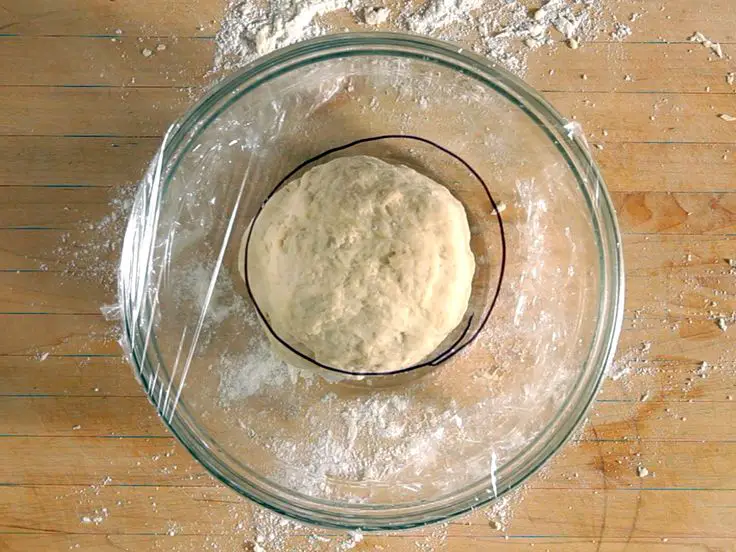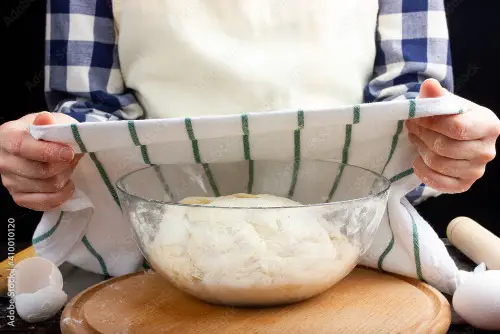When baking bread, one of the most critical steps is letting the dough rise.
But with all that time and effort rising—is it really necessary to cover the dough?
Let’s take a closer look at why covering your dough can be beneficial for your homemade bread.
Contents
Reasons Why People Cover The Dough:
Here are some benefits of covering the dough which make people want to cover the dough:
1. Moisture Retention:
One of the main benefits of covering your dough while it rises is moisture retention.
Covering your dough helps trap in the steam released from its surface, which in turn keeps your dough moist and fluffy throughout its rise.
If you choose not to cover the dough while it rises, you may end up with dry spots on the loaf or even a tougher crust than desired.
Additionally, if you’re making something like cinnamon rolls or dinner rolls instead of a free-form loaf, keeping them covered will help them retain their shape as they rise and bake.
2. Temperature Control:
Covering your dough also helps regulate temperature.
When exposed to air, yeast reacts quickly and tends to over-activate which can lead to an unevenly risen loaf of bread or other baked goods.
Covering your dough allows you to maintain more consistent temperatures so that the yeast activates more slowly and evenly throughout the entire process, giving you a better-finished product in the end.
3. Prevents Stickiness:
Another benefit of covering your dough while it rises is preventing stickiness from forming on its surface.
If left uncovered in a warm environment, some types of dough (like egg-based brioche or challah) can become too sticky to work with after rising and will require additional flouring before shaping into loaves or rolls.
Covering these types of dough during their rise prevents this stickiness from forming so you don’t have to worry about extra flouring later on in the process.
The Consequences of Not Covering Dough:
If you don’t cover the dough, it will become dry and harden.
Why does this happen?
When exposed to air, the yeast cells in the dough use up the available moisture in order to keep themselves alive and active. This process is called respiration, which explains why uncovered dough becomes dry quickly.
Additionally, without a barrier between itself and the atmosphere, the dough can become contaminated with bacteria or other microorganisms that can alter its flavor and texture.
Not all types of dough need to be covered; some are best left uncovered or lightly covered. Bread such as sourdough should not be tightly sealed because they need to breathe during proofing (when yeast grows).
Yeast bread with high-fat content—such as brioche—should also not be tightly sealed because they require room to expand while rising.
On the other hand, pizza crusts should always be covered while rising because they are dense and have very little fat content.
How To Cover The Dough Properly?
- If using plastic wrap or aluminum foil for covering, make sure that it is sealed tightly around the edges of the bowl so that no air can enter or escape.
- You may also consider using a damp towel instead of plastic wrap; this will help keep moisture in without trapping too much condensation inside the bowl which could affect its texture or flavor.
- In addition, try not to leave your dough in direct sunlight since this could cause it to overheat and become gummy rather than light and fluffy.
- Finally, pay attention to expiration dates on any ingredients used – expired ingredients can lead to spoilage or foodborne illnesses!
The Different Ways to Cover Dough:
Here we will discuss the different ways you can cover your dough.
1. Plastic Wrap and Foil:
Wrapping your dough in plastic wrap or foil is often the simplest way to cover it.
Plastic wrap works especially well because its tight seal keeps the dough from drying out in the refrigerator.

However, if you’re looking for something a bit more decorative, then foil wrapping may be the better option.
Foil gives a nice shiny finish that adds an extra touch of elegance to any pastry dish.
2. Using Dough Pieces:
Another method for covering dough is by using other pieces of dough. This works particularly well with some types of bread and pastries, such as panettone and stollen.
To do this, simply take small pieces of leftover dough and flatten them out before placing them over the top of your dough.
You can also add additional flavorings or ingredients like nuts or dried fruits if desired.
3. Egg Wash
Egg washing is another common way to cover the dough before baking it.
Egg wash is made by combining one egg with a tablespoon or two of milk or water and whisking together until combined.
Then simply brush the egg wash over your dough with a pastry brush before baking it in the oven. This helps give your pastries a golden brown color while also adding a glossy finish that looks great!
It also helps keep moisture locked into your pastries so they stay soft and fluffy on the inside even after baking.
How To Revive Stale Dough?
The most important thing to remember is not to panic if your dough dries out—it happens more often than you think. The good news is that there are a few simple tricks that you can use to bring it back to life.
- The first step is to add moisture back into the dough. Depending on what type of recipe you’re working with, this could mean adding a tablespoon or two of water or milk.
- Make sure the liquid is warm; cold liquids will make the dough too soft and sticky.
- If your recipe calls for butter, try adding a pat instead of water or milk; this works especially well with sugar cookie and shortbread recipes.
- Once you have added liquid to the dough, knead it gently until it has reached an even consistency throughout.
- If the dough still seems dry, add more liquid as needed until it reaches the desired texture.
- Keep in mind that too much liquid can make the dough difficult to work with and can cause it to become soggy once baked. You may also need to adjust cooking times accordingly if you’ve added extra liquid since longer cook times may be required for wetter ingredients (like butter).
- If all else fails, refrigerating your dough for about 10 minutes before continuing can help restore some moisture as well as holding everything together when rolling out or cutting shapes from your cookie dough.
It’s also recommended that you always store unused dough covered in plastic wrap so it stays fresh and moist until you’re ready for your next baking session!
Should I Cover The Dough With a Wet or Dry Towel?
When covering your dough with a towel, it’s important to use a dry one. Wet towels can cause the dough to stick and become soggy, which can ruin your final product.
A dry towel will help keep moisture out while allowing the dough to breathe and remain pliable so you can work with it as necessary.

Additionally, be sure not to wrap the towel too tightly around the dough as this can also cause it to become soggy.
If you’re having trouble removing the towel from the dough, try using a butter knife or other utensil to gently pry it away.
Once your dough is covered with a dry towel, you can store it in the refrigerator to keep it from rising and becoming over-proofed.
This will give you more time to work with the dough when it’s ready for use. With these tips, you can keep your dough fresh and pliable for any type of baking needs!
By following these simple steps, you can easily cover your dough in a variety of ways.
Should Dough Be Covered Airtight?
No, the dough should not be covered airtight. This can cause the dough to become too moist and sticky, resulting in an unpleasant texture when baked.
Instead of covering your dough with an airtight seal, use a dry towel or plastic wrap to lightly cover it while allowing some airflow. This will help keep the dough from drying out while also allowing it to remain pliable and ready for shaping.
Additionally, storing dough in the refrigerator will help keep it from rising too quickly, giving you more time to work with it when ready.
By following these simple steps, you can easily ensure that your dough remains fresh and ready to use whenever you need it!
Can You Leave Dough Covered for Too Long?
Yes, you can leave the dough covered for too long. If it is left sitting out in a warm environment or if the covering traps in too much moisture, the dough can become soggy and difficult to work with.
Additionally, letting the dough sit for too long will cause it to rise quickly which can make it hard to roll out or shape properly.
When storing dough, cover it lightly with a dry towel or plastic wrap and refrigerate if needed.
This will help keep the dough fresh and prevent it from becoming over-proofed. If you’re not using the dough immediately, place it in the freezer to keep it fresher for longer periods of time.
Conclusion:
Covering your dough while it rises can be beneficial for a variety of reasons including moisture retention, temperature control, and prevention of stickiness formation on its surface; all leading up to a perfect finished product!
Whether you are making a free-form loaf or something like cinnamon rolls or dinner rolls—it’s always best practice to keep those buns covered!
But remember—it’s not just about covering that baking vessel—you should also make sure that whatever material you use is breathable enough so that moisture can escape without allowing too much air in!
With this knowledge in mind, go forth and bake some delicious homemade bread!
Amazon and the Amazon logo are trademarks of Amazon.com, Inc, or its affiliates.

